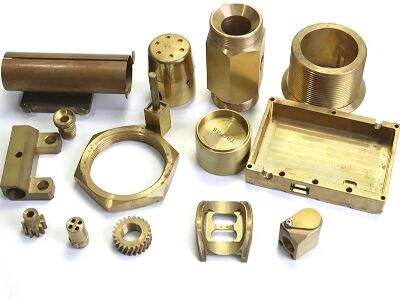På Svärd Precision , förstår vi att för varje företag är tillverkning av en metallkomponent en ganska krävande uppgift. Många platser, som för bilar och plan… och också många maskiner kräver metallkomponenter. Eftersom dessa är så avgörande element, behöver du särskilt noggrant överväga hur du ska genomföra dem. 2 HUVUDMETODER FÖR FORMNING AV METALLDELEN Metallets pressning och den klassiska processen för traditionell maskinbearbetning är två av de vanligaste processerna för produktion. Denna post syftar till att undersöka fördelar och nackdelar med dessa två metoder. Här på basis av detta kommer de att få veta vilken som passar bäst för deras företag.

Så, Vilken Av Dessa Passar Ditt Företag Bäst?
När du försöker välja mellan metallpressning och traditionell maskinbearbetning som Cnc-mackning , det finns några mycket viktiga saker som du också måste tänka på. DET FÖRSTA du behöver göra är att avgöra vilken typ av del du vill skapa. En enklare eller mer komplex mönster? Men tänk på hur många delar du måste bygga efter detta. Behöver du många av dem, eller bara några få? Sist men inte minst, ta reda på hur mycket du är beredd att investera i detta. Varje metod har sina fördelar och nackdelar, så du bör känna till båda innan du väljer.
Jämförelse mellan Metallpressning vs Traditionell Mekanisk Bearbetning Fördelar och Nackdelar
Metallpressning Fördelar:
Det skulle vara ineffektivt att skära varje del separat från resten, vilket är en stor anledning till att metallpressning kan skära tusentals delar på en dag. Denna metod låter dig uppfylla den beställningen om du får en stor.
En av fördelarna med metallslagning är att denna process håller nära toleranser och skapar mycket precisa delar enligt exakta specifikationer. På så sätt kommer alla delar att vara i samma enhet i det slutliga produkten.
Det kan också använda olika material - lika stora fördelar. Detta skulle då låta dig välja vilket material som är mest lämpligt för dina delar.
Metallslagning är också mer kostnadseffektivt när du producerar din produkt i storskalor. Detta kan på sikt bli till fördel för ditt företag.
Nackdelar med metallslagning:
Men, metallslagning och GJUTNING har också några nackdelar - det kommer INTE att vara till fördel för dig om du behöver få delar och vill minska produktionsekvenskostnaden. Men när din beställning är liten måste du ta detta i beaktning.
Tja, det är inte fallet med metallslagning. Denna metod kommer att vara svår för dig om du föredrar en annan form.
Metallpressning är praktisk, men den kan begränsa saker du kan göra och att sätta upp en matris kan bli mycket kostsamt! Om ditt design är komplicerat kanske du behöver en annan metod.
Den tredje begränsningen är att metallpressning inte kan användas på material som är svåra att pressa. Det skapar mer av en prisbarriär och ökar antalet material du är begränsad till.
Traditionell maskinbearbetning Fördelar:
Samtidigt ger klassisk maskinbearbetning också fördelar. Utmärkt för att producera komplexa prototyper och delar. Fördelar: Om ditt design redan är färdigställt, kan detta vara en utmärkt lösning.
Traditionell maskinbearbetning: Du kan också använda en mängd olika material som i ekvationer 6–8. Du får en ökad möjlighet att välja material för dina delar.
Om du bara behöver få delar producerade för ditt företag kan traditionell maskinbearbetning vara billigare när det gäller verktygskostnader. Detta är en mer kostnadseffektiv alternativ för mindre beställningar.
Detta är också bra för att bygga prototyper. Till exempel, om du har ett nytt produktutformat som behöver bevisas — en preliminär test är troligen möjlig att utföra med traditionell maskinbearbetning.
Nackdelar med Traditionell Maskinbearbetning:
Dock kan denna huvudinstans ändras så att hålen uppdateras. Traditionell maskinbearbetning har också sina begränsningar. Huvudproblemet är att delarna ofta tar längre tid att göra än metallstämpning. Det kan faktiskt bli ett problem om du behöver delar snabbt.
Dessutom, i stora mängder kan traditionell maskinbearbetning vara mer kostnadseffektiv. Tja, nu föreställ dig att du producerade packningar av delarna och att detta sätt inte är optimalt.
Fördelen med sådan skärning är att, i jämförelse med vissa vanligare maskinbearbetningsmetoder, kommer delarna att skäras med mindre precision och konsekvens. Dessa skillnader kan påverka resultatet.
Slutligen kan traditionell maskinbearbetning bara användas för att göra små delar. Om dina komponenter är bredare kanske det inte fungerar lika bra.
Metallstämpning vs Konventionell Maskinbearbetning
Metallstämpning:
Dream Tech Teknik: Dream Tech En teknik genom vilken plattmaterial kan utvecklas till en viss form med hjälp av Metal Stamping gravurmatris, där i en matris det grova materialet som ska formas skärs. Formbarhet: Målden skär metallen i vilken form som helst du vill. Denna akvösa tvättprocess är en av de snabbaste och mest kostnadseffektiva sätten att rengöra stora mängder delar. Idealiskt för att rätta eller göra dart-utsparningar, men inte lika bra när komplexa designmönster måste följas eller när komplicerade former kräver skärning.
Traditionell Bearbetning:
I motsats till traditionell bearbetning har du ett material som är en block och delar tas bort för att få den slutgiltiga formen. Traditionell bearbetning av olika slag som bohrning, fräsning, snedning etc., kan vara bra för komplexa känsliga former, men när du måste leverera massor av delar snabbt kan det ta för lång tid.
Saker att Tänka På
Dock finns det flera viktiga faktorer att ta hänsyn till när du väljer den du kommer att använda mest:
Formkomplexitet: Metallpressning fungerar bäst för platta och böjda profiler. Men du kanske måste återgå till en enskilt punkts bohrtéknik om din design är särskilt svår.
Hastighet: Metallpressning är mycket snabbare - Stora mängder delar är mer lämpliga med kortare bearbetningstid genom att använda metallpressning. Om du behöver väldigt få delar kan den gamla metoden med maskinbearbetning vara snabbare.
Designval begränsar metallpressning till viss del. I motsats till detta kan de flesta maskinerade delarna göras i nästan vilken form som helst du vill.
Material: Som en regel är metallpressning avsedd för när du har mycket tunna material, och traditionell maskinbearbetning fungerar bra med en rad olika material.
Om du producerar lite åt gången kommer verktygen att bli dyrmare - Pressning har högre verktygs kostnader för allt mindre än 1 del. Uppgiften ovan är det motsatta av den föregående, traditionell maskinbearbetning kan bli dyrt för stora beställningar.
Jämförelse mellan metallpressning och traditionell maskinbearbetning
Metallpressning använder Lammmetall , till sist, är utmärkt för att producera många delar snabbt och presterar bra i platta former samt relativt shallow böjda former. De är CAD-korrekta och helt reproducerbara resultatdelar. Dock är det en blockmodell så inte mycket design kan utföras och det finns inget stöd för komplexa former. På andra sidan är den mer traditionella maskinbearbetningen intressant för småserieber beställningar och komplexa former. Det kan vara långsamt och inte lika precist, men det kan hantera en bred variety av material för att skapa vilken del du önskar.

